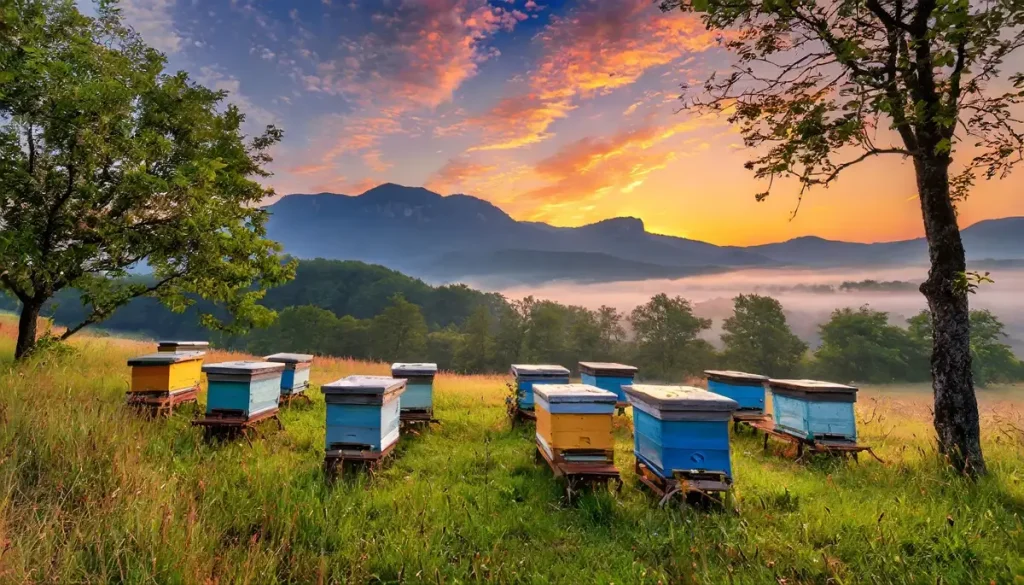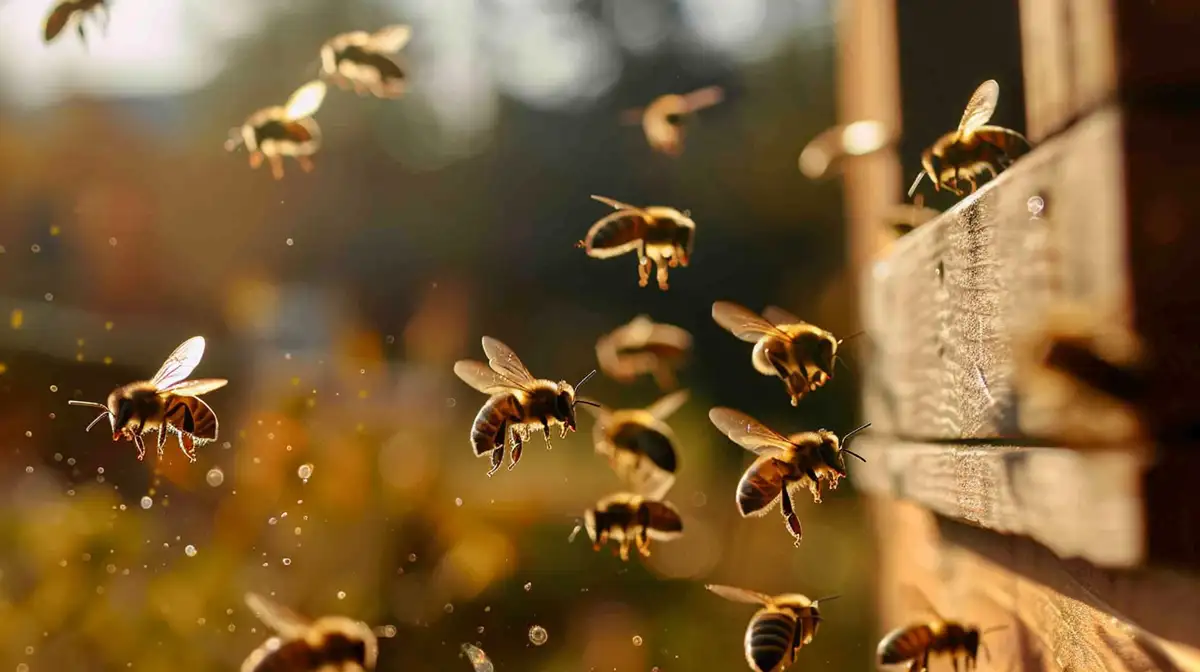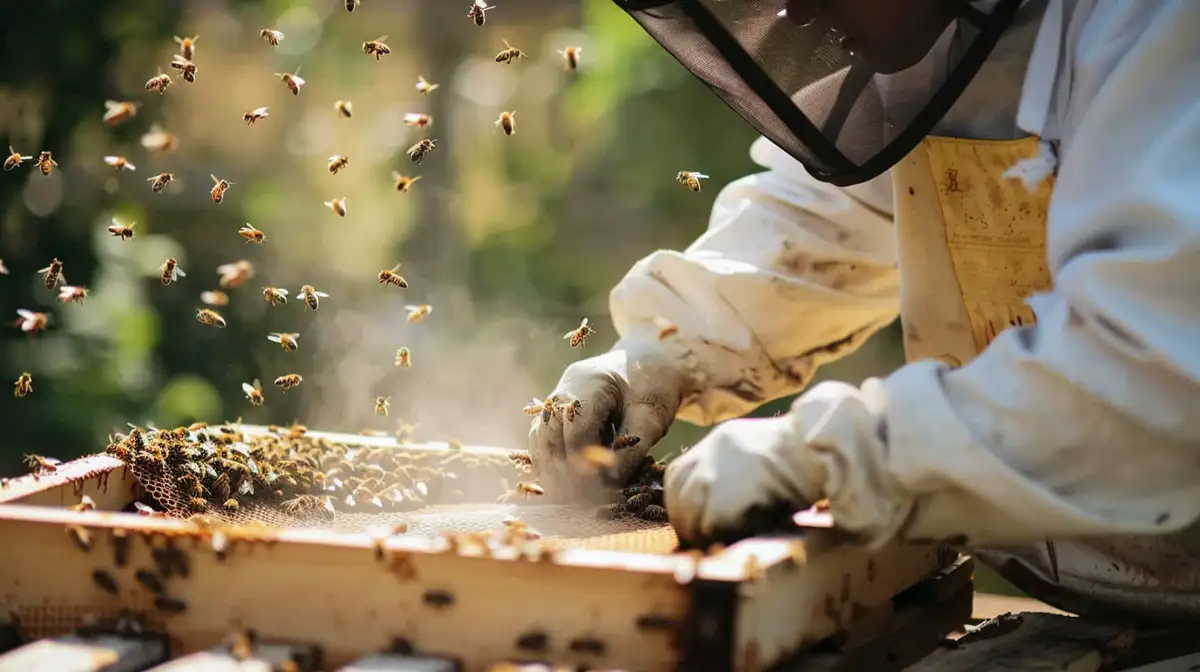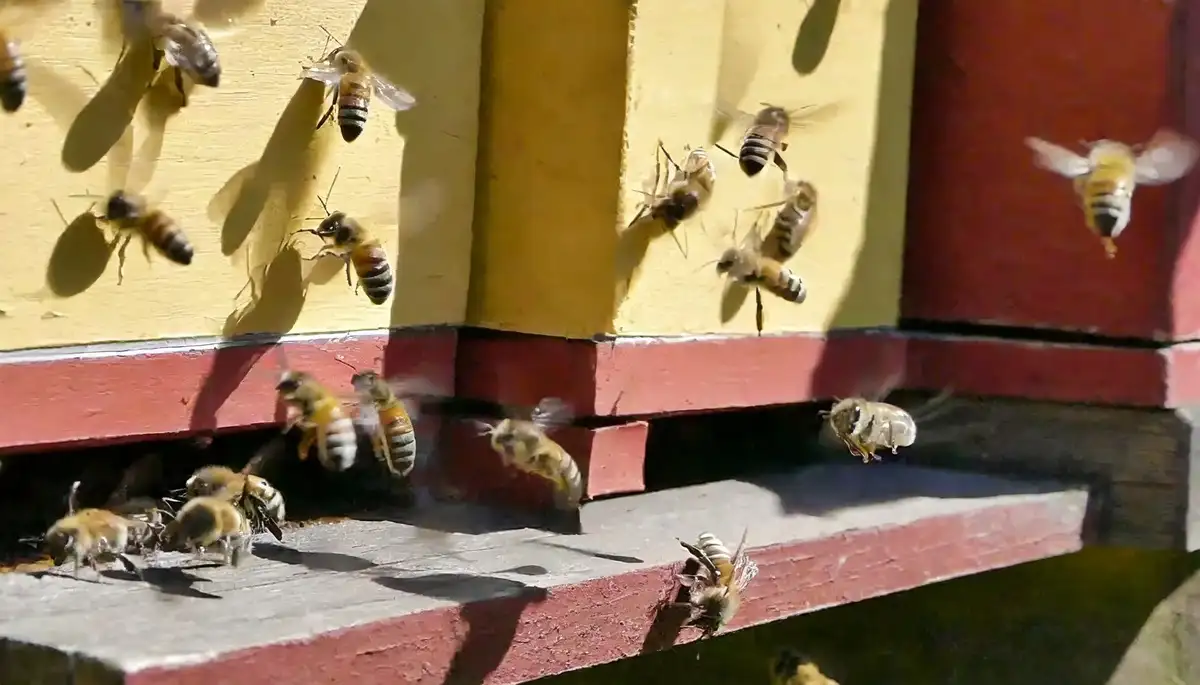Table of Contents
Beekeeping, an ancient practice vital for the sustainability of our ecosystems, offers unique challenges and rewards. This guide is designed to navigate beginners through the intricate process of establishing an apiary, ensuring a solid foundation for fostering healthy bee colonies. From site selection to the intricacies of hive management, this article delves into essential techniques and sustainable practices for successful beekeeping. Alongside, it presents practical advice and strategic insights aimed at optimizing the productivity and well-being of your bees. Embarking on this journey promises not only the cultivation of golden nectar but also contributes significantly to the preservation of biodiversity and the support of pollination ecosystems. Let us guide you through the essential steps to create a thriving haven for bees, emphasizing the importance of each decision in the path to becoming a conscientious beekeeper.
How to Build an Apiary – Site Selection
The first step in creating a successful apiary is selecting a suitable site. Choosing the right location is crucial as it can have a significant impact on the health and productivity of your bees. When selecting an apiary location, there are several factors to consider:
- Proximity to nectar sources and water: Bees need access to nectar and water to survive. Ensure that your apiary is located near a variety of nectar sources, such as wildflowers, orchards, and gardens and a reliable source of water, such as a pond or stream.
- Protection from elements and predators: Bees are sensitive to extreme weather conditions, so choose a location that provides shade and shelter from strong winds, rain, and direct sunlight. Additionally, protect your apiary from predators such as bears, skunks, and raccoons by using an electric fence or other effective deterrent. Note: While using an electric fence or other effective deterrents can significantly reduce the risk of predator attacks on your apiary, it’s vital to ensure these protective measures are not set-and-forget solutions. Regular maintenance and vigilant monitoring of your apiary’s perimeter are essential to safeguard against predators effectively. Inspect fences for damage or signs of tampering and check electric fences for proper voltage regularly. This proactive approach helps ensure that your defenses remain robust, keeping bears, skunks, raccoons, and other predators at bay. Additionally, consider employing motion-activated lights or noise devices as supplementary deterrents to further enhance the security of your bee colonies.
- Accessibility for beekeeper: You will be visiting the apiary regularly, so choose a location that is easily accessible, with a flat and level surface to work on.
- Local regulations and laws: Before you start your apiary, research local regulations and laws to ensure that you are complying with any permits or requirements.
Here is a comprehensive table that outlines key considerations and recommendations for choosing the optimal location for an apiary.
| Factor | Description | Recommendations |
|---|---|---|
| Nectar and Pollen Sources | Availability of diverse foraging options for bees, affecting their nutrition and the hive’s honey production. | Choose a site near abundant sources of nectar and pollen, such as wildflowers, gardens, orchards, and natural meadows. Diversity in flora supports bees’ nutritional needs throughout the seasons. |
| Water Availability | Bees need a consistent water source for cooling the hive, humidity control, and consumption. | Ensure a clean, reliable water source is within a short flying distance (ideally less than a quarter mile away). Consider creating a bee-friendly water station if natural sources are not available. |
| Sunlight and Shade | Proper balance affects hive temperature and bee activity. | Select a location that receives morning sunlight and partial afternoon shade to keep bees active while protecting them from extreme afternoon heat, especially in warmer climates. |
| Wind Protection | High winds can cool hives too much, making it difficult for bees to maintain the necessary temperature for brood rearing. | Choose a site with natural windbreaks like trees, shrubs, or terrain features. Alternatively, consider installing artificial barriers such as hedges or fences. |
| Rain and Moisture Protection | Excessive moisture can lead to hive diseases and discomfort for bees. | Avoid low-lying areas prone to flooding or dampness. Slightly elevated or well-draining sites are preferable to keep hives dry. |
| Temperature and Climate | Regional climate conditions influence bee activity, survival rates, and honey production. | Consider the local climate, including winter harshness and summer heat, and adapt hive placement and insulation accordingly to protect bees from extreme temperatures. |
| Accessibility | Ease of access for regular maintenance, inspections, and honey harvesting. | Ensure the site is easily reachable by foot or vehicle, considering all seasons. A flat, stable surface for setting up equipment is also crucial. |
| Safety and Security | Protection from predators, vandals, and unintentional disturbances. | In areas prone to bear or other large predator visits, consider fencing, particularly electric fencing. Ensure the apiary is not easily accessible to unauthorized persons or pets to reduce risks. |
| Regulatory Compliance | Adherence to local zoning laws, regulations, and distance requirements from neighbors or public spaces. | Research and comply with local ordinances regarding beekeeping. Some areas may require hives to be a certain distance from property lines or public areas. |
| Future Expansion | Potential for adding more hives or infrastructure as the apiary grows. | Select a site that allows for the growth of your beekeeping operation, with enough space to add more hives or related structures like storage sheds or honey processing areas. |
This table provides a structured approach to evaluating potential sites for an apiary, ensuring that all critical factors are considered to promote a healthy and productive beekeeping endeavor.
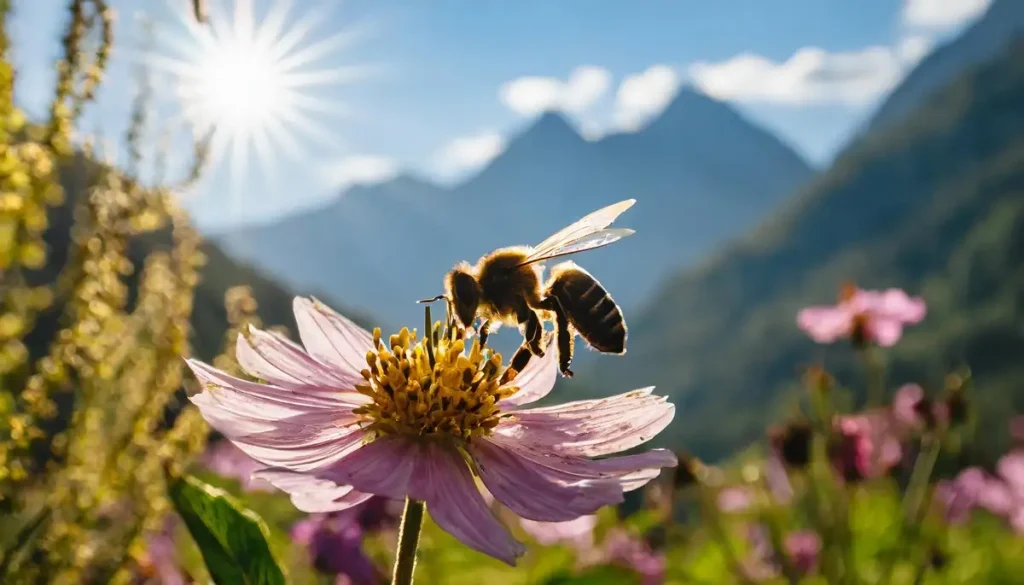
Apiary Site Preparation
Proper site preparation is essential to ensure the success of your apiary. Taking the time to prepare the area before installing your hives will help create a healthy environment for your bees, improve accessibility for you, and minimize the risk of hazards. Here are some key aspects to consider during apiary site preparation:
Clearing Vegetation and Debris
Before setting up your hives, clear the area of any tall grass, weeds, and debris. This helps to reduce the risk of pests and diseases, as well as minimize the chances of a fire spreading to your hives. By removing obstacles and creating a clear path to your apiary, you’ll also have easier access for maintenance and inspection tasks.
Leveling and Stabilizing the Ground
A stable, level surface is crucial for the proper functioning of your hives. Uneven ground can lead to improper hive alignment and make it difficult for bees to access the hive. To level the ground, remove any rocks or obstacles, fill in any holes or depressions, and compact the soil. If necessary, use paving stones or other materials to create a stable base for your hives.
Installing Fencing and Barriers
Depending on your location and the specific risks in your area, you may need to install fencing or barriers to protect the apiary from predators, livestock, or other hazards. Electric fences can be an effective deterrent against bears and other large animals while smaller barriers or fencing can help keep out pests like skunks and raccoons. In addition, barriers like windbreaks can be installed to protect your hives from strong winds, and shade structures may be necessary to provide relief from direct sunlight during hot summer months.
Planning for Accessibility and Future Expansion
As you prepare your apiary site, keep in mind your need for accessibility and the potential for future expansion. Ensure that you have enough space to maneuver around the hives, transport equipment, and perform regular maintenance tasks. Leave room for additional hives in case you decide to expand your apiary in the future, and consider how the placement of your current hives may impact the overall layout and efficiency of the site as it grows.
Hive Placement
Once you have chosen the location for your apiary, the next step is to decide on the placement of your hives. Hive placement is critical because it can affect the health and productivity of the bees. Here are some factors to consider when placing your hives:
- Orientation of the hive: The entrance of the hive should face southeast or south to maximize exposure to sunlight and minimize exposure to wind and rain. Note: While the general recommendation is to orient the entrance of the hive to face southeast or south to maximize exposure to sunlight and minimize exposure to prevailing winds and rain, it’s crucial to adapt this advice based on your local climate and environmental conditions. In regions where strong winds come from the south or southeast, for example, it might be beneficial to slightly adjust the hive’s orientation to protect it from such elements. Similarly, in areas with harsh winters, positioning hives to receive more sunlight during the colder months can help maintain colony warmth. Always observe your local weather patterns and landscape to determine the optimal orientation for your hives, ensuring they have the best possible protection and exposure to natural resources.
- Distance between hives: Hives should be spaced at least three feet apart to prevent overcrowding and allow bees to move freely between hives.
- Hive elevation: Hives should be elevated at least 18 inches above the ground to prevent flooding and reduce the risk of disease and pests.
- Sun and shade exposure: Hives should be placed in an area that receives some shade during the hottest part of the day and plenty of sunlight in the morning and early afternoon.
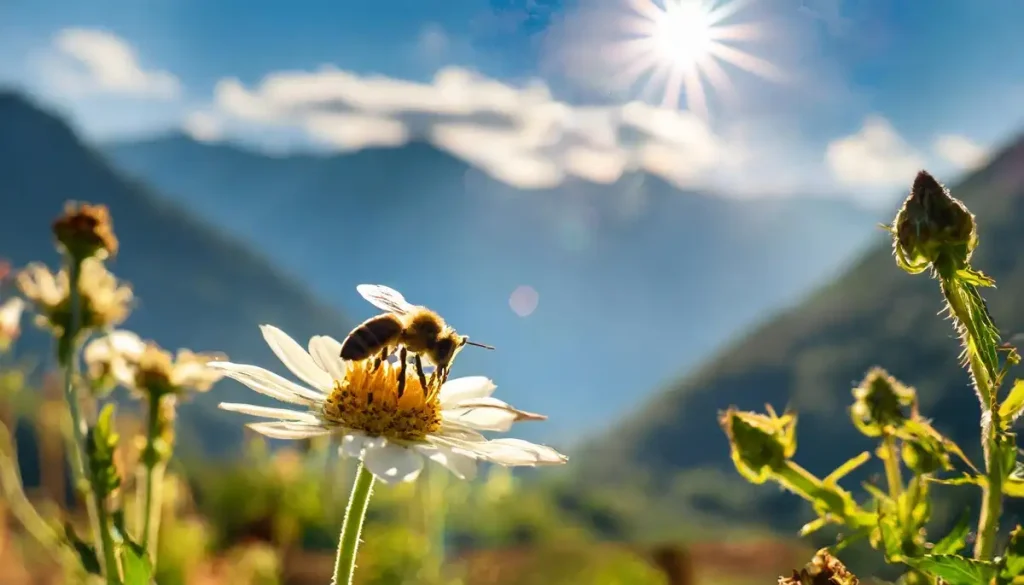
Bee Species Selection
Selecting the appropriate bee species for your apiary is a crucial step in ensuring the success of your beekeeping endeavors. Different species of bees have varying temperaments, honey production capabilities, and climate preferences, so it is essential to choose a species that aligns with your beekeeping goals and local environmental conditions. Some of the most common bee species used in beekeeping include the European honey bee, the Italian honey bee, the Carniolan honey bee, and the Russian honey bee.
Selecting the appropriate bee species is a crucial decision in setting up your apiary, with the European honey bee, Italian honey bee, Carniolan honey bee, and Russian honey bee being among the popular choices. However, beyond these well-known species, it’s essential to consider the importance of local adaptation in your bee selection process. Local bee strains or hybrids may offer better survival and productivity rates in your specific environment due to their adaptation to local climate conditions, flora, and disease pressures. Engage with local beekeeping associations, clubs, or extension services to gain insights into the bee species or strains that thrive in your region. These local resources can provide valuable advice on the bees that are best suited for your area’s environmental conditions and challenges, including disease resistance and climate adaptability. Opting for locally adapted bees can lead to healthier colonies, enhanced productivity, and a more resilient apiary.
When selecting a bee species, consider factors such as the local climate, the species’ adaptability to temperature fluctuations, and their resistance to diseases and pests. For example, the Italian honey bee is known for its gentle temperament, high honey production, and adaptability to a wide range of climates. The Carniolan honey bee, on the other hand, is valued for its exceptional foraging abilities in cooler temperatures and its resistance to some common bee diseases. The Russian honey bee is recognized for its high resistance to Varroa mites, a common pest that can devastate bee colonies.
- Carter, Anthony (Author)
- English (Publication Language)
- 194 Pages - 02/28/2024 (Publication Date) - Independently published (Publisher)
Another important factor to consider when selecting a bee species is the availability of specific bee breeds in your area. Local beekeeping associations, clubs, and suppliers can be valuable resources for acquiring bees and obtaining advice on the most suitable species for your region. Moreover, sourcing bees from a reputable supplier can help ensure that you start with healthy, disease-free colonies, setting the stage for a successful apiary.
Here is a comprehensive table that outlines key characteristics of popular bee species to help guide the selection process for starting an apiary:
| Criteria/Species | European Honey Bee (Apis mellifera) | Italian Honey Bee (Apis mellifera ligustica) | Carniolan Honey Bee (Apis mellifera carnica) | Russian Honey Bee (Apis mellifera caucasica) |
|---|---|---|---|---|
| Temperament | Varies widely; generally docile | Very gentle and easy to manage | Docile, but can become defensive if threatened | Known for being more aggressive than other species |
| Honey Production | High | High, consistent producers | Moderate to high, depending on forage availability | Moderate, efficient in resource use |
| Swarming Tendency | Moderate to high | Low to moderate, less prone to swarming | High, particularly in crowded conditions | Variable, with some strains showing lower swarming tendencies |
| Winter Hardiness | Moderate | Moderate, requires well-stocked food supplies | Excellent, adapts well to cold climates | Good, with some cold tolerance |
| Disease Resistance | Varies by strain | Susceptible to some diseases and mites | Good resistance to some diseases and mites | High resistance to Varroa mites |
| Foraging Behavior | Good foragers | Excellent foragers, work well in varied climates | Excellent foragers, particularly in cooler temperatures | Efficient foragers, but may require closer food sources |
| Climate Adaptability | Good, adaptable to various climates | Thrives in warmer and temperate climates | Well-suited for cooler and temperate climates | Adapted to cooler climates and mountainous regions |
| Brood Rearing | Early spring to late summer | Early and prolific brood rearing | Quick to start brood rearing in spring | Brood rearing aligned with resource availability, potentially reducing mite load |
| Pest Resistance | Varies by strain | Generally lower resistance to pests | Moderate resistance to pests | High resistance to Varroa mites, some resistance to other pests |
| Management Needs | Moderate, depending on strain | Low, ideal for beginners | Moderate, responsive to beekeeper interventions | High, requires vigilant management for mite resistance |
Note: The characteristics listed in this table are generalizations and can vary based on specific strains within each species, local environmental conditions, and beekeeping practices. It’s crucial for beekeepers to consider their local climate, forage availability, and personal beekeeping goals when selecting a bee species. Consulting with local beekeeping clubs or extension services can provide valuable insights into which species or strains might perform best in your area.
Apiary Expansion and Swarm Management
Planning for Apiary Expansion
As your apiary grows and thrives, it is crucial to plan for its expansion to accommodate more colonies or increased honey production. Consider the available space at your current site as well as the potential need for additional resources such as equipment and supplies. As you expand, make sure to maintain an appropriate distance between hives to prevent overcrowding and ensure the bees can move freely. If necessary, you may need to secure additional land or relocate to a larger site to accommodate your growing apiary.
Swarm Prevention and Capture
Swarming is a natural process wherein a colony divides to create a new colony, usually in response to overcrowding or other environmental factors. To minimize the chances of swarming, regularly inspect your hives, provide adequate space for the growing colony, and replace old or damaged equipment. If you notice signs of swarming, such as queen cells, consider splitting the colony to prevent the swarm from occurring.
Swarming is a natural behavior for bees, signaling a healthy and expanding colony. However, managing swarming is crucial to prevent loss of bees and to maintain productivity. While the article mentions regular hive inspections and providing adequate space as preventive measures, understanding the underlying causes of swarming can further enhance your swarm management strategies. One effective approach is brood chamber management, which involves periodically checking and managing the space where the queen lays eggs to ensure it’s not too crowded. This can be done by adding new frames or boxes, or by practicing techniques such as splitting the hive if it becomes too populous.
Another timely intervention is supering, which means adding extra boxes for honey storage before the colony becomes overcrowded, providing them with more space to store honey and reducing the urge to swarm. It’s also beneficial to monitor for signs of queen cells, as these are an indication that the hive is preparing to swarm. If found, you can decide to preemptively split the hive, thereby managing the swarm proactively.
By incorporating these detailed strategies into your swarm management practices, you can minimize the chances of swarming and ensure that your colonies remain productive and healthy. Remember, swarming isn’t just about overcrowding; it’s a complex behavior influenced by multiple factors, including the age of the queen, hive conditions, and seasonal changes. A comprehensive approach to swarm management considers all these aspects, aiming for a balance that respects the bees’ natural instincts while aligning with your beekeeping goals.
In cases where a swarm does occur, it is essential to capture the swarm quickly and safely to prevent the loss of bees and ensure they do not establish a new colony in an undesirable location. To capture a swarm, you will need protective gear, a bee brush or gentle method to collect the bees, a suitable container or hive box, and a method to transport the swarm back to your apiary.
Managing New Colonies
Once a swarm is captured or a colony is split, you will need to manage the new colony to ensure its successful integration into your apiary. This includes providing a suitable hive, monitoring the health and productivity of the colony, and addressing any issues that may arise, such as pests or diseases. As the new colony grows, you may need to provide additional resources, such as more honey supers or brood boxes, to accommodate its expansion.
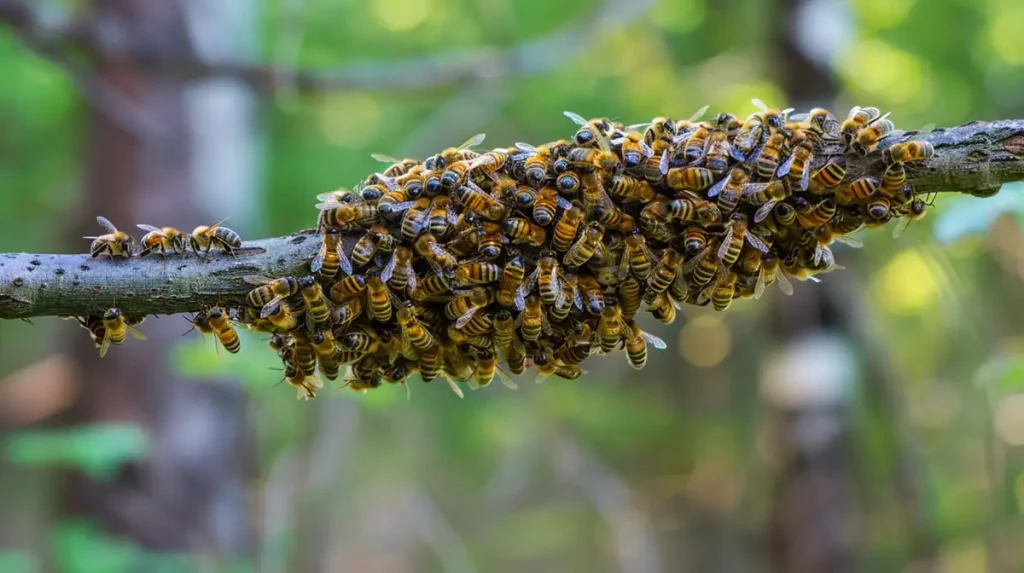
Hive Management
Proper hive management is critical for maintaining the health and productivity of your bees. Here are some essential tips for managing your hives:
- Monitoring hive health: Regularly inspect your hives to ensure that your bees are healthy and active. Look for signs of disease, such as deformed wings, unusual behavior, and decreased honey production.
- Controlling pests and diseases: Use integrated pest management strategies to control pests such as mites, wax moths, and hive beetles. Always use organic and non-toxic methods whenever possible to protect the health of your bees.
- Feeding and supplementing bees: During times of nectar scarcity or drought, bees may need to be supplemented with sugar syrup or pollen substitute. Ensure that they have adequate food supplies to prevent starvation and to support brood production.
- Maintaining hive equipment and frames: Regularly clean and maintain your hives and equipment to prevent the spread of disease and pests. Replace frames as needed, and always use new foundation in your frames to prevent the spread of pathogens.
To ensure the health and longevity of your bee colonies, a deeper dive into integrated pest management (IPM) strategies is essential. IPM focuses on sustainable and environmentally friendly methods to prevent and manage pests and diseases within your apiary. Begin by emphasizing the importance of regular hive inspections to identify early signs of pest infestations or diseases. For instance, Varroa mites, one of the most detrimental pests to honey bees, require diligent monitoring and management. Techniques such as drone comb removal, powdered sugar dusting, and the use of organic acids like formic or oxalic acid can be effective, non-chemical methods for Varroa control.
Similarly, addressing bee diseases such as American foulbrood or Nosema involves strict hygiene practices and, in severe cases, may require the removal and destruction of infected colonies to prevent spread. Always prioritize biosecurity measures, such as sanitizing tools and equipment and implementing quarantine protocols for new or returning colonies.
Moreover, incorporate the practice of selecting disease-resistant bee strains and advocating for natural breeding practices that enhance genetic diversity and resilience against pests and diseases. Engage with local beekeeping communities to share knowledge and strategies for pest and disease management, fostering a collective effort towards healthier bees and more sustainable beekeeping practices.
Record Keeping and Documentation
Importance of Record Keeping
Maintaining detailed records of your apiary is a crucial aspect of successful beekeeping. By keeping track of hive inspections, honey production, pest and disease treatments, and other relevant information, you can effectively monitor your apiary’s health and productivity over time. This data can help you identify patterns, trends, or issues that may require attention and allow you to make informed decisions about the management of your apiary.
Hive Inspection Records
Regular hive inspections are essential for assessing the health of your bee colonies. When inspecting your hives, note the presence and condition of the queen, brood pattern, honey and pollen stores, and signs of pests or diseases. Documenting these details can help you track colony development, identify potential problems early, and plan appropriate interventions.
Honey Production Records
Keeping records of your honey production enables you to analyze trends and measure the success of your apiary. Note the dates, quantities, and characteristics of each honey harvest, such as the color, aroma, and flavor profile. This information can help you understand how various factors, such as seasonal nectar flows or hive management practices, influence the quality and quantity of your honey.
Pest and Disease Treatment Records
Documenting your pest and disease treatments is essential for effective apiary management. Record the dates, methods, and outcomes of any treatments you apply, as well as any observations of pests or diseases in your hives. This information can help you evaluate the effectiveness of your pest and disease management strategies and make informed decisions about potential changes to your approach.
Other Relevant Information
In addition to the specifics mentioned above, it’s helpful to record other relevant information about your apiary, such as weather patterns, local flora and nectar flows, and any changes to your beekeeping practices or equipment. By maintaining a comprehensive record of your apiary’s history, you can gain valuable insights into the factors that influence the health and productivity of your bees, allowing you to optimize your beekeeping practices over time.
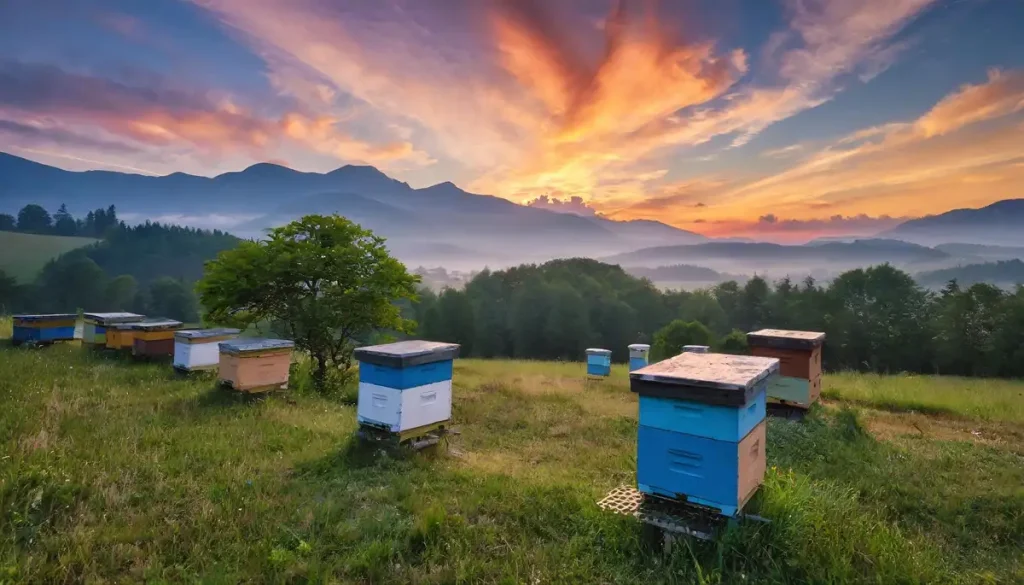
Seasonal Beekeeping Tasks
Beekeeping is a year-round endeavor, with each season presenting unique challenges and tasks that are essential for maintaining a healthy and productive apiary. Understanding and preparing for these seasonal responsibilities can help ensure the well-being of your bees throughout the year.
Spring
Spring is a busy time for beekeepers as the colonies begin to grow and expand. During this season, it’s crucial to monitor the health of the queen and the brood, as well as to ensure that there is enough space within the hive to accommodate the growing population. Perform regular hive inspections and be prepared to add more frames or boxes to the hive as needed. Additionally, consider providing supplemental food sources, such as sugar syrup or pollen patties, to support the colony’s growth and development.
Summer
As temperatures rise in the summer, ventilation becomes a critical concern for beekeepers. Ensure that your hives have proper ventilation to prevent overheating, which can cause bees to become stressed or die. Consider adding a screened bottom board or other ventilation options to help maintain a comfortable temperature within the hive. Additionally, monitor the water sources available to your bees and ensure that they have access to fresh water during hot and dry periods.
Fall
Fall is the time to prepare your hives for the winter months ahead. Begin by assessing the health and strength of each colony, as well as the amount of honey stores available. If a colony is weak or has insufficient honey stores, consider combining it with a stronger colony to improve its chances of survival. Treat any pests or diseases and remove any dead or dying bees from the hive. Finally, provide insulation for the hives, such as wrapping them in a protective material or using a windbreak, to help keep the bees warm during the cold months.
Winter
During the winter, beekeeping tasks primarily focus on monitoring the health and well-being of the hives. Regularly check the hives for signs of moisture, as excess moisture can lead to mold growth or cause bees to freeze. Clear snow and ice from the entrances to ensure proper ventilation and avoid trapping bees inside. Additionally, keep an eye on the honey stores in each hive, as bees will need to consume their stored honey to generate heat and survive the winter. If necessary, provide supplemental food sources, such as sugar bricks or fondant, to help sustain the colony until spring arrives.
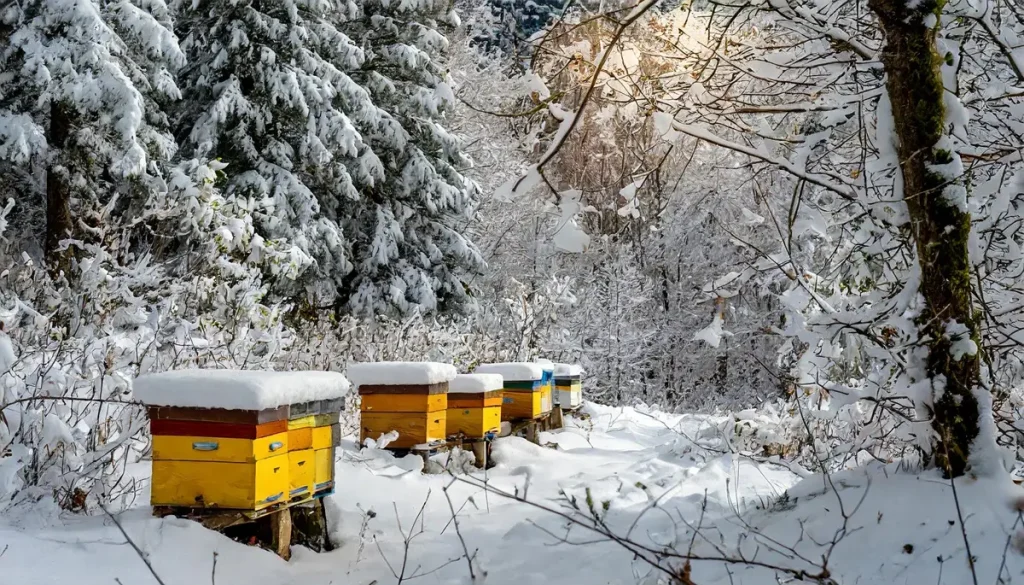
Apiary Safety and First Aid
Beekeeping Safety Measures
When working in an apiary, it is essential to prioritize safety for both the beekeeper and the bees. Wearing appropriate protective gear, such as a beekeeping suit, gloves, and a veil, can significantly reduce the risk of bee stings. Additionally, using a smoker to calm the bees before inspecting or working with the hives can make the process safer and less stressful for both parties.
It’s also important to move slowly and deliberately when working with the hives to avoid sudden movements that might agitate the bees. Be mindful of your surroundings and any potential hazards, such as uneven ground or obstacles that may lead to accidents. Lastly, ensure that your apiary is secure from unauthorized access, especially by children and pets, to prevent unintentional injuries.
Handling Bee Stings and Allergic
Bee stings are an inevitable part of beekeeping, and it is crucial to know how to handle them appropriately. If stung, remove the stinger as soon as possible by scraping it out with a fingernail or the edge of a credit card. Avoid using tweezers, as this can release more venom into the wound. Once the stinger is removed, wash the area with soap and water and apply a cold pack to reduce swelling and pain.
Allergic reactions to bee stings can range from mild to severe. For mild reactions, over-the-counter antihistamines or anti-inflammatory medications can help alleviate symptoms. However, severe allergic reactions, such as anaphylaxis, require immediate medical attention. If a person exhibits signs of anaphylaxis, such as difficulty breathing, rapid pulse, or swelling of the face or throat, call emergency services and administer an epinephrine auto-injector (e.g., EpiPen) if available.
First Aid Training and Preparedness
Beekeepers should consider undergoing first aid training to be prepared for emergencies that may arise in the apiary. This training will equip you with the skills and knowledge necessary to handle a variety of situations, including bee stings, allergic reactions, and other injuries. Additionally, keep a well-stocked first aid kit in a readily accessible location within the apiary, containing essential items such as antihistamines, pain relievers, bandages, and an epinephrine auto-injector if prescribed.
Community Engagement and Education
Building Connections with Local Community
One of the essential aspects of successful beekeeping is establishing a connection with your local community. By building relationships with neighbors, schools, and local organizations, you can create a supportive environment for your apiary and contribute to a better understanding of the importance of bees and beekeeping.
Start by reaching out to your neighbors and discussing your apiary plans. Address any concerns they might have and offer to share information about the benefits of having a healthy bee population in the area. Providing resources and answering questions can help alleviate fears or misconceptions about bees.
Educational Programs and Workshops
Develop educational programs and workshops to introduce the community to the world of bees and beekeeping. Collaborate with local schools, community centers, and gardening clubs to organize presentations or hands-on activities that highlight the vital role bees play in pollination, food production, and ecosystem health.
These programs can cover various topics, such as the life cycle of bees, how honey is made, and the challenges bees face, including habitat loss, pesticides, and disease. By providing engaging and interactive experiences, you can inspire community members to appreciate and support bees and local beekeeping efforts.
Bee-Friendly Initiatives
Promote bee-friendly initiatives within your community, encouraging residents and local businesses to create pollinator-friendly habitats by planting flowers and native plants that provide food sources for bees. Offer guidance on selecting appropriate plants and using environmentally-friendly gardening practices that minimize the use of pesticides.
Organize community events like tree planting drives, habitat restoration projects, or pollinator garden installations to involve the community in hands-on conservation efforts. By working together, community members can actively contribute to supporting local bee populations and enhancing the overall health of the ecosystem.
Sustainability Practices in Beekeeping
Incorporating sustainable beekeeping practices is not only beneficial for the environment but also crucial for the health and productivity of your apiary. Emphasize the significance of promoting biodiversity in and around your beekeeping area. Encourage the planting of a diverse range of flowering plants, shrubs, and trees that bloom at different times of the year, providing bees with a continuous source of nectar and pollen. Highlight the importance of avoiding the use of pesticides and chemicals in gardening and farming practices near the apiary, as these substances can be harmful to bees and other pollinators.
Discuss the role of natural habitat conservation, urging readers to maintain or restore areas that support wild bee populations and other pollinators. This can include setting aside portions of land as natural habitats, participating in local conservation efforts, or simply allowing weeds and wildflowers to grow in certain areas.
Moreover, address the significance of water conservation in beekeeping. Guide readers on creating bee-friendly water sources, such as shallow water dishes with stones or marbles for bees to land on, and stress the importance of clean, accessible water for bee health.
Finally, advocate for the practice of minimal intervention beekeeping, where the natural behaviors and lifecycle of bees are respected. Encourage beekeepers to adopt methods that minimize stress and intervention, such as using non-invasive inspection techniques, allowing bees to build natural comb structures, and only harvesting surplus honey to ensure that bees have enough food for the winter.
How to Build an Apiary – Conclusion
In conclusion, beekeeping is a fascinating and rewarding hobby that requires careful planning and attention to detail to create and maintain a successful apiary. By following the tips on site selection, hive placement, hive management, and honey harvesting, you can establish and maintain a healthy and productive bee colony. Remember to monitor your hives regularly, protect your bees from predators and disease, and provide them with a safe and suitable environment to thrive. With these tips and techniques, you can enjoy the benefits of beekeeping and the satisfaction of contributing to the health of our environment.
Looking to up your beekeeping game? Check out our latest product recommendations so you can take things to the next level!
Introducing The Top 12 Best Beekeeping Veils For 2024
Introducing The Top 20 Best Beekeeping Gloves For 2024
Introducing The Absolute Best Beekeeping Suits For 2024
The 15 Top Beekeeping Books for 2024
The Top 11 Honey Extractors for 2024
The Top 12 Mason Bee Houses for 2024
Beekeeping Disclaimer:
Beekeeping, like any agricultural activity, involves inherent risks. It is important to understand these risks and take appropriate measures to mitigate them.
Potential risks associated with beekeeping include:
- Bee stings: Honey bees are generally not aggressive but can become defensive if they feel threatened or their hive is disturbed. Bee stings can cause allergic reactions or even anaphylaxis in some individuals, which can be life-threatening. It is important to wear protective clothing and follow best practices when handling bees to minimize the risk of stings.
- Diseases and pests: Bees can be vulnerable to various diseases and pests, including mites, viruses, and bacterial infections. These can have significant impacts on bee colonies, leading to reduced honey production or even colony collapse. It is important to monitor hives regularly and take appropriate measures to prevent and treat diseases and pests.
- Weather conditions: Extreme weather conditions, such as drought or cold temperatures, can affect the health and productivity of bee colonies. It is important to ensure that hives are appropriately sheltered and provided with adequate food and water.
- Environmental hazards: Bees can be affected by environmental hazards such as pesticide exposure, pollution, and habitat loss. It is important to be aware of these hazards and take appropriate measures to protect bee colonies and promote healthy environments for bees.
- Legal requirements: Beekeeping may be subject to local, state, or national regulations, such as registration or inspection requirements. It is important to be aware of these requirements and comply with them.
While beekeeping can be a rewarding and enjoyable activity, it is important to be aware of the potential risks and take appropriate measures to mitigate them. By following best practices and staying informed about the latest developments in beekeeping, beekeepers can help ensure the health and productivity of their hives and contribute to the well-being of bee populations worldwide.
Medical Disclaimer: The content provided in this blog post is for informational purposes only and is not intended as medical advice, or to replace the advice of a healthcare professional. Bee stings can cause allergic reactions in some individuals, which can be severe and require immediate medical attention. Similarly, consuming bee products, including honey, pollen, propolis, and royal jelly, can cause adverse reactions in people with specific allergies or intolerances. If you experience any negative reactions or are unsure about your allergies, consult with a healthcare provider promptly. The views expressed in this article are based on current knowledge and do not cover all possible health implications. Always seek the advice of your physician or another qualified health provider with any questions you may have regarding a medical condition or before starting any new treatment.
Last update on 2024-05-02 / Affiliate links / Images from Amazon Product Advertising API

